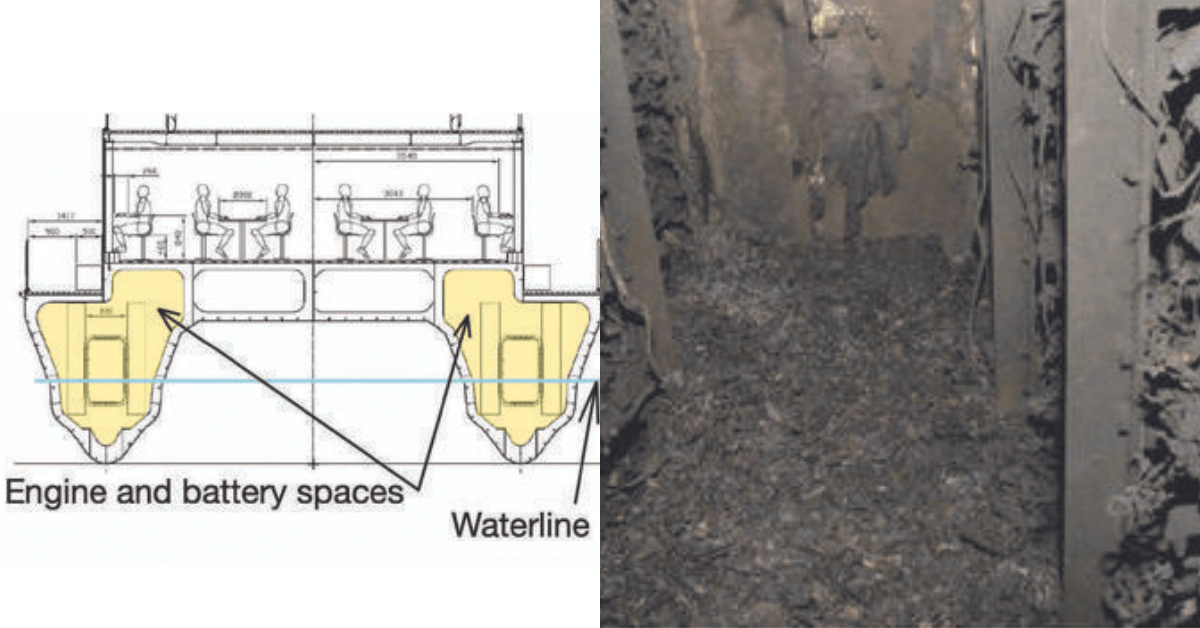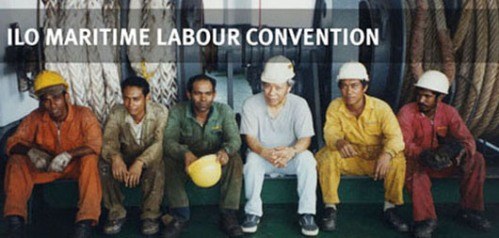Real Life Incident: Wet Batteries Cause Serious Fire On Vessel
A small hybrid passenger catamaran vessel was underway in coastal waters, with no passengers on board, when the fire alarm sounded. The fire alarm panel indicated fire in both the battery room and the engine room in the starboard pontoon. An engineer opened the door to the starboard engine room and saw smoke. He immediately closed the door to reduce the air admission. The port engine and batteries in the port pontoon were still operational.
The crew believed the starboard engine room to be the seat of the fire, and the fire suppression agent Novec was released into the starboard engine room. About seven minutes later the crew released Novec into the battery room. These measures had the effect of temporarily slowing down the smoke development. A search and rescue (SAR) vessel soon arrived on the scene and evacuated the four crew. The catamaran was towed to port and extinguishing efforts continued for several days before the vessel was considered safe to board.
Technical examinations showed that the fire started in a battery stack module. It is highly probable that seawater ingress through the ventilation outlet had leaked through the ventilation fan and down onto the batteries. This caused a short-circuit and electric arcs, which were considered to be the source of the fire.

Important information about flooding points from the ventilation system to the battery room was missing from the freeboard plan. This meant that the regulatory personnel responsible for approving the freeboard plan were unaware of the position of the ventilation outlet and the risk that it posed. After the accident, the vessel owners have made several changes to the ventilation system.
The investigation also showed that the battery system had a low ingress protection (IP) rating, so that when seawater entered the battery modules and high-voltage components there were severe consequences. A higher IP rating (and therefore a higher degree of protection) would have reduced the consequences of seawater ingress to the battery room. It would appear that the regulations do not sufficiently address the need for ingress protection of battery systems.
- Lessons learned
- Because the fire was incorrectly understood to be in the engine room, approximately seven minutes passed before the extinguishing agent was released to the battery room. In order to be effective, a fire suppression agent needs to be released quickly and, if possible, automatically.
- Battery safety as a whole was not adequately addressed in the regulations. The risk assessment relating to the battery system did not reflect all risks associated with the system. For example, the risk of seawater ingress through the ventilation arrangements was missed.
- The ingress protection (IP) rating of marine battery systems should be carefully considered.
- Classification societies may have different requirements for battery safety, which can result in different vessels having different standards of battery safety. Based on current rules and regulations, the same error may occur again.
- At present, there is no fire suppression system that is capable of safely extinguishing a lithium-ion fire.
- Novec can be considered unsuited as a fire suppression agent in battery rooms because of the complexity of correct use, its poor cooling effect and the fact that it devolves into toxic gases at high temperatures.
Editor’s note: With the ongoing electrification of all transportation modes including seagoing vessels, this accident is an important milestone. The Lessons Learned mentioned above are an edited summary of the plethora of serious and as yet unaddressed risks uncovered during the investigation. Interested readers are advised to consult the original report for more detailed information.
Disclaimer :
The information contained in this website is for general information purposes only. While we endeavour to keep the information up to date and correct, we make no representations or warranties of any kind, express or implied, about the completeness, accuracy, reliability, suitability or availability with respect to the website or the information, products, services, or related graphics contained on the website for any purpose. Any reliance you place on such information is therefore strictly at your own risk.
In no event will we be liable for any loss or damage including without limitation, indirect or consequential loss or damage, or any loss or damage whatsoever arising from loss of data or profits arising out of, or in connection with, the use of this website.
Do you have info to share with us ? Suggest a correction
Disclaimer :
The information contained in this website is for general information purposes only. While we endeavour to keep the information up to date and correct, we make no representations or warranties of any kind, express or implied, about the completeness, accuracy, reliability, suitability or availability with respect to the website or the information, products, services, or related graphics contained on the website for any purpose. Any reliance you place on such information is therefore strictly at your own risk.
Related Articles
Daily Maritime News, Straight To Your Inbox
Sign Up To Get Daily Newsletters
Join over 60k+ people who read our daily newsletters
By subscribing, you agree to our Privacy Policy and may receive occasional deal communications; you can unsubscribe anytime.





BE THE FIRST TO COMMENT